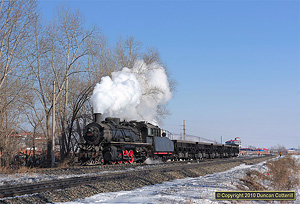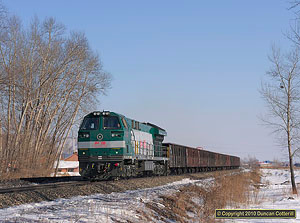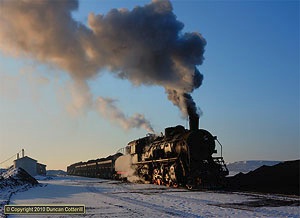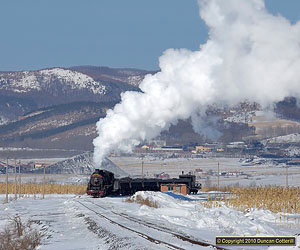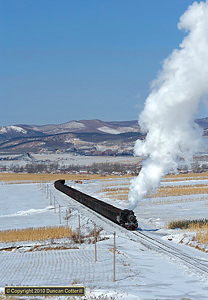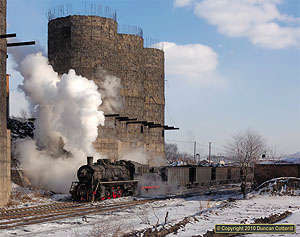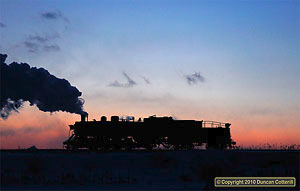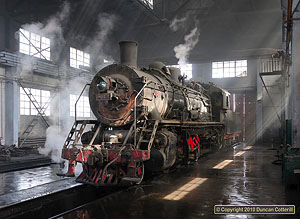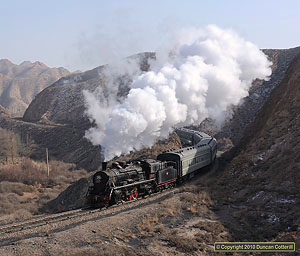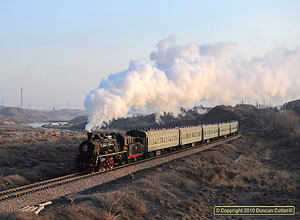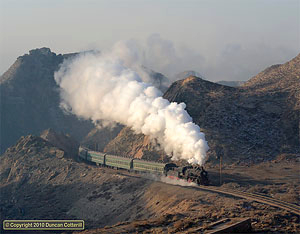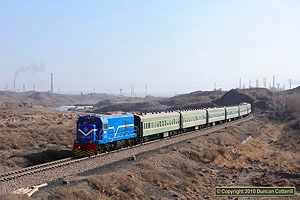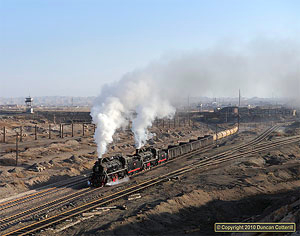Jixi and Baiyin
01 - 14 March 2010
Report by Duncan Cotterill
Introduction
This report describes a two-week photographic trip to China in early March 2010. Our group consisted of Peter Breeze, Sun Xiaolan and myself with Robin Gibbons joining us for the first half of the trip. We divided our time between the coal mining railways around Jixi, in the north-east, and the mineral lines around Baiyin, in the mid-west, both still largely worked by SY class 2-8-2s.
This report is divided into two parts: This page contains a summary of the trip. The Day by Day section contains details of each day’s activities, trains seen, travel, hotels etc.
Travel Arrangements
Peter and I flew from the UK to Beijing with Air France, meeting up with Robin and Xiaolan in Beijing. Arrangements within China were all made by Xiaolan. Long distance travel was by air between Beijing and Mudanjiang, for Jixi, and Beijing and Lanzhou, for Baiyin. We travelled by road for all other journeys.
Jixi Mining Railway
We spent five days photographing the mine railways around Jixi from 3 to 7 March 2010.
Chengzihe
No significant changes over the last year or so. There are no signs of electrification work yet and the system continues to be 100% steam operated. Traffic levels did seem to be down a bit with the hopper trains from Dongchang to Beichang operating less frequently than at times in the past. There also seemed to be less traffic from Xinghua mine with the morning empties from Dongchang, often a heavy train in the past, consisting of around 5 wagons on one day, a light engine the next and not running at all on the third and fifth days. Only on the fourth day was it a good sized train. The spoil trains from Beichang have reverted to their traditional destination of the tips north of the line between Dongchang and Zhengyang, instead of going west to a tip near to the new mine west of Qiaonan.
Locos :
SY 0804, 0863, 1018, 1058, 1340, 1351, 1369, 1437 all in use.Didao
Like Chengzihe, 100% steam and operating normally but with fewer trains than in previous years. Trains were running to the spoil tip on the hillside above Lijing mine but only when we weren’t trying to photograph them.
Locos :
SY 0407, 0950, 1205, 1213, 1446 all in use.Donghai
Usually a quiet system but seemed to be quite busy during our only visit on 5 March, probably just luck. The pilot engine ran from Donghaikuang down to the junction to double head the empties up to the mine at lunchtime and then another train of loads was due to go down to Jidong in the afternoon.
Locos :
SY 0639, 0746 in use.Hengshan
One brief visit found the diesels working the majority of trains, as expected, but still a little work for steam.
Locos :
SY 1344, GKD1A 0106 in use.Lishu
We didn’t visit Lishu this time.
CR Jixi Area
There have been big changes on the main line with brand new GE class HXN5, based at Harbin, displacing the Mudanjiang based DF8s from most freight work on the line west to Linkou. A number of DF8 were seen on lesser duties on the Linkou line and also on the Xiachengzi line, where they appear to have replaced DF4Bs. No DF4Bs were seen at all during our stay in Jixi. The two passenger trains we saw, K7077 and K7078 were hauled by Sankeshu based DF4DKs.
Locos :
DF4D 3019 (SKS), 3033 (SKS), DF8 0087 (MDG), HXN5 0102 (HRB), 0120 (HRB), 0159 (HRB), 0170 (HRB).Baiyin Mineral Railway
We spent five days on the lines of the Baiyin Non-ferrous Metals Company (BNMC), from the afternoon of 8 March to the morning of 13 March 2010. The railway had just acquired its first diesels but steam remained in use on most duties.
The first diesel, GKD1A 0206, was mainly used on the ore trains from Shenbutong to Baiyin. As last year, the timing of these trains was very erratic and the empties could appear at any time from early morning to early afternoon with the loads returning 90 to 120 minutes later. On some days the GKD1A would also work the afternoon Sanyelian passenger and sometimes it also filled in on trips and shunts around the complex or up to Sanyelian. The second diesel, DF7G 5183 had only arrived on the railway on 6 March and spent most of its time either on the depot being pored over by fitters or trundling up and down the yard at Baiyin Gongsi. It did occasionally do a bit of shunting but didn’t really cause us any problems.
The Shenbutong passengers were solidly steam with the same loco working the 07:50, 15:15 and 18:15 trains each day. This loco faced the opposite way to all the others, so it was always chimney first uphill. SY 1470 worked the train on the first few days and then SY 2008 took over until the last day when SY 1470 returned to service after a washout and minor repairs. The morning Sanyelian passengers were always steam but the afternoon trains were GKD1A hauled on the first three days and then SY 1581 took over for the last couple of days, running tender first uphill. The passenger timetable can be found here.
Trips and shunts around the yard and complex were mostly steam with SY 0965 and SY 1581 handling most of the work. The diesels occasionally did a little shunting but the vast majority of workings were steam. One of the highlights of our visit was seeing SY 1581 and SY 0965 double heading a heavy train up the bank from the complex to Gongsi yard with both engines working flat out and the crews clearly enjoying every minute of it. Both locos were commendably clean, as was the principal passenger loco, SY 1470.
The slag trains were all steam hauled, mainly by SY 1583, but SY 1047 was also used. There seemed to be two slag trains, each with its own engine. The one we saw most often consisted of a caboose, SY 1583, five flat wagons and three slag ladles in that order. The other train consisted of a loco, two flat wagons and two slag ladles.
On our first visit to the depot, it appeared that SY 0612, SY 0819 and SY 1047 were out of traffic and probably victims of the new diesels. Later visits saw SY 1047 steamed and then back in traffic while SY 0819 was confirmed as awaiting repairs. SY 0612 had suffered severe damage to the motion on one side and was probably considered not worth repairing with the first diesels on their way. The fact that SY 1013 was undergoing an overhaul indicates that some steam work will continue for a while at least. We heard a number of different stories from staff about what was planned and much of the information was inconsistent. One theme that seemed to be common was that steam would finish in around two years.
Security was tight on the line up to Shenbutong with a new checkpoint just beyond the level crossing south of Liugongli as well as the long established one at the south end of the Sanyelian complex. We had a permit displayed in the windscreen but were usually stopped and checked, particularly on the way out. Our permit specifically excluded us from travelling on the passenger trains or going beyond Dongchanggou, the last halt before Shenbutong.
Locos :
SY 0965, 1047, 1470, 1581, 1583, 2008 (all in use), SY 1013 (overhaul), SY 0819 (awaiting repairs), SY 0612 (stored unserviceable). DF7G 5183 (on test), GKD1A 0206 (in use).Honglu Aluminium, Baiyin
Apart from the locos working for the BNMC there are several more steam locos based in the area. We tried to check out the Honglu Aluminium Factory on 12 March but weren’t allowed to enter the premises. We were informed that diesels were now used and an independent witness confirmed that SY 1596 and SY 1597, previously reported in use here, were now dumped on site.
CR Baiyin Area
We saw a number of trains on the CR line from Baiyin Xi to Changzheng and Honghui. Everything was hauled by standard green DF4Bs, including the daily passenger train. Some of the heavier freights were double headed. A CR DF4B also visited Gongsi yard every lunchtime to exchange traffic with the BNMC.
Going Home
The long journey home should have been straightforward but didn’t quite work out that way. We flew back to Beijing then returned to the UK via Amsterdam with KLM, eventually.
Comments and Conclusions
The weather was the biggest problem we encountered during the trip. Jixi was still firmly in the grip of winter and there were a couple of heavy snowfalls and quite a lot of cloud while we were there. Baiyin started off very cold but by the time we left it was getting too warm for exhausts in the afternoon. Despite having northerly winds much of the time, we didn’t really get the clear light we had hoped for.
Although Jixi appeared to be quieter than some previous trips it was still busy enough and far busier than most other surviving locations. Even if the entire Chengzihe system is electrified this year, there should still be enough left at Didao, Lishu and Donghai to make another visit worthwhile next winter.
Unfortunately the same can’t be said for Baiyin. There’s little chance that the Shenbutong passengers will stay steam until next winter and there isn’t much else there to justify another visit. Baiyin was never my favourite steam location. There weren’t enough trains, the visibility usually seemed poor and the morning and afternoon passengers only seemed to be lit at times of year when it was too warm. However, the thrash was phenomenal, not only on the Shenbutong line but also on the lines from the complex back up the hill into Gongsi Yard. I’ll be sad to see Baiyin go.
I keep on asking myself how much longer steam can last. At the moment there’s not only enough left to justify another visit, there’s actually too much to see on a single trip. Most of the really great locations have gone but Jixi, Huanan and Sandaoling are still well worth a visit and there are a number of other places like Fuxin, Beipiao, Beitai and Pingzhuang to fill in the gaps. It isn’t time to hang the cameras up yet.
This report is divided into two parts: This page contains a summary of the trip. The Day by Day section contains details of each day’s activities, trains seen, travel, hotels etc.
